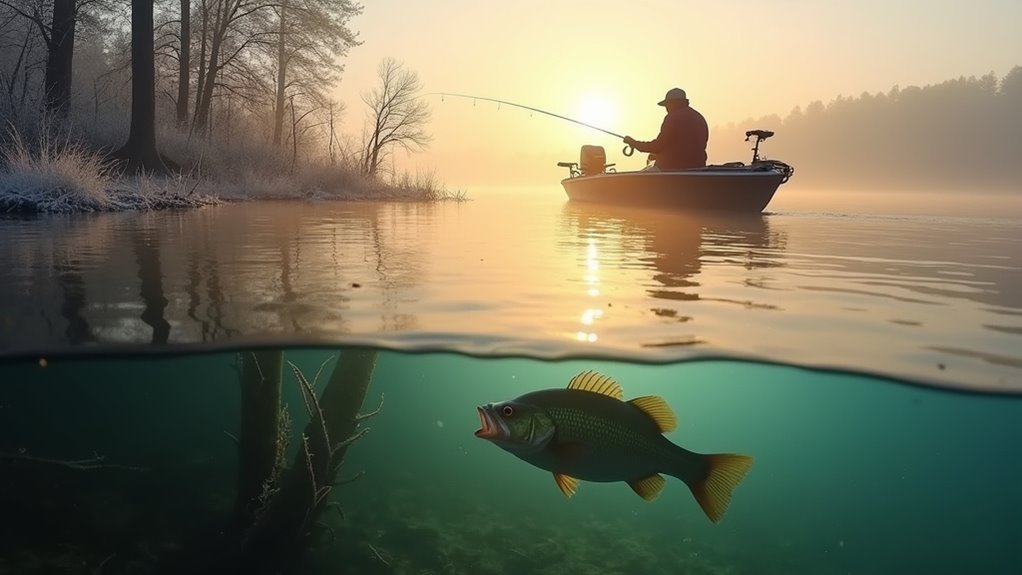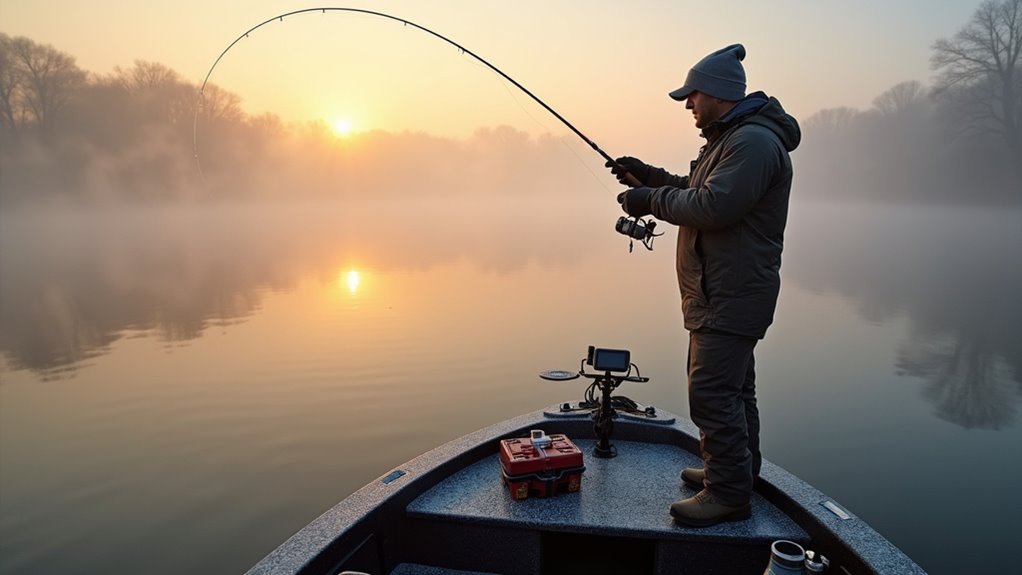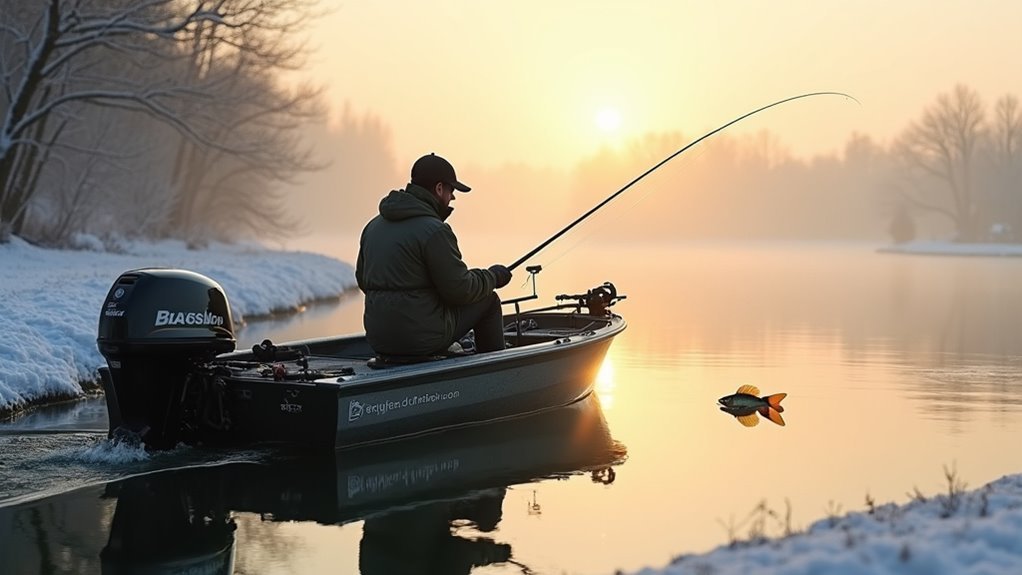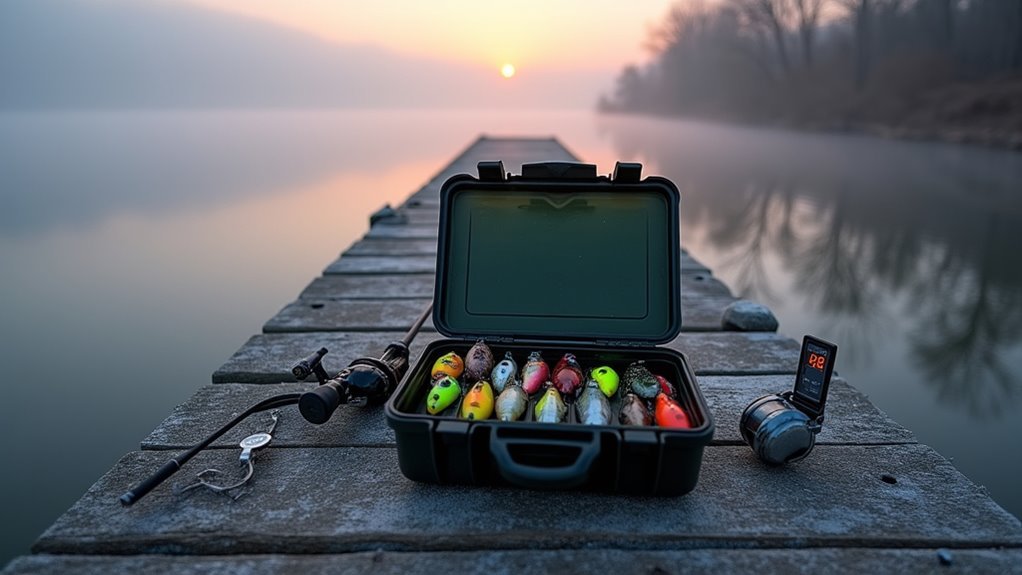We’ve found that winter bass fishing requires slowing everything down. As temperatures drop below 50°F, bass metabolism slows and they congregate in deeper water, only moving shallow on sunny days. We’ll catch more fish by targeting drop-offs, using smaller lures, and retrieving them painfully slow. Layer up with waterproof gear and thermal clothing to stay comfortable during those long waits between bites. The right approach during cold months can yield some of your biggest catches yet.
The Science Behind Bass Behavior in Cold Water

When temperatures plummet below 50 degrees F, bass transform into entirely different creatures than their warm-water counterparts. We’ve noticed their metabolism slows dramatically, causing them to move less and react slower to potential meals.
Over years of winter fishing, we’ve learned bass bunch up in deeper waters during the coldest months. They’re conserving energy, plain and simple. On sunny days, we’ve found them moving to shallow flats that shift to deep water – these spots give them access to food without burning precious energy.
Unlike summer bass, these winter fish want smaller, slower-moving meals. Their behavior changes completely – and so should your approach.
Finding Prime Winter Bass Locations

We’ve found our best winter catches near drop-offs where shallow flats shift to deep water. These spots let bass conserve energy while accessing food. On sunny days, focus on the warmer shallows along river shores where bass congregate.
We’ve noticed bass gathering in the deepest lake sections during cold snaps. They’re typically hanging out in large groups, making your first catch a good sign more are nearby. Remember, look for baitfish – where they go, bass follow, especially near shores in winter months. Additionally, ensuring your trolling motor has adequate thrust for the conditions can significantly improve your chances of reaching these prime spots effectively.
Essential Gear for Cold Weather Fishing Success

Through years of braving winter’s chill, we’ve learned that proper gear isn’t just about comfort—it’s the difference between success and misery on the water. We’ve seen even the toughest anglers call it quits when their fingers go numb.
Layer up with waterproof outerwear and thermal base layers. Don’t forget insulated, waterproof gloves—they’re game-changers when you’re unhooking a bass in January!
Keep specialized winter lures handy: blade baits, smaller jerkbaits, and slow-moving jigs are our go-tos.
Slow and Steady: Perfecting Your Winter Presentation

With the right gear protecting us from winter’s bite, let’s shift our focus to what ultimately matters most—how we present our lures to cold-water bass.
Remember when I caught that five-pounder last February? It wasn’t from speed—it was patience! Cold-water bass need a different approach:
- Slow down your retrieve—way down
- Make smaller movements with your rod tip
- Let jigs barely crawl along the bottom
- Count to five between jerks on suspending baits
- Match your pace to the water temperature—colder means slower
Trust me, in winter fishing, the tortoise beats the hare every time. Additionally, managing your battery capacity effectively can ensure your trolling motor lasts throughout your fishing trip, allowing you to focus on those slower presentations.
Top Lure Selections for Sub-50° Waters

Since bass become notoriously picky eaters when temperatures plummet below 50°F, choosing the right lure can make the difference between a successful day and going home empty-handed. We’ve spent countless winter mornings testing what works when the mercury drops.
| Lure Type | Best Depth | Retrieval Speed |
|---|---|---|
| Blade Baits | 15-30 ft | Slow lift & drop |
| Jerkbaits | 5-15 ft | Pause 5-10 seconds |
| Shaky Heads | 10-25 ft | Minimal movement |
| Lipless Crankbaits | 5-20 ft | Slow, steady crawl |
Remember to downsize your offerings in winter. We’ve seen finicky bass reject full-sized lures only to hammer the smaller version minutes later.
Reading Weather Patterns for Better Winter Catches
While selecting the perfect lure can put you in the game, understanding weather patterns can tell you exactly when to play. We’ve caught our biggest winter bass right before storms roll in, when that barometric pressure starts dropping.
Dropping barometric pressure signals prime bass fishing moments – nature’s dinner bell before the storm arrives.
- Watch for warming trends – even a few degrees can trigger feeding frenzies
- Pay attention to sunny days – shallow areas warm faster, drawing active bass
- Monitor barometric pressure – falling pressure often means it’s time to fish
- Focus on calm periods between cold fronts for best results
- Don’t ignore wind direction – south winds typically bring warmer conditions
Frequently Asked Questions
How Long Should I Fish a Spot Before Moving On?
We recommend staying at least 20-30 minutes before moving on. In cold water, bass react slowly, so give your spot time. If you’ve varied retrieves and depths without success, it’s time to relocate.
Can Bass Fishing Be Productive During Snowfall?
Yes, we’ve found bass fishing can be productive during snowfall. Bass often feed actively before and during light snow. We recommend focusing on deeper water edges and using slow presentations with downsized lures in these conditions.
Should I Use Scented Baits in Cold Water?
We definitely recommend using scented baits in cold water. They’ll help entice sluggish bass with slower metabolisms to bite, as their enhanced smell draws attention even when bass aren’t actively searching for food.
How Does Ice Affect Bass Fishing in Partially Frozen Lakes?
We’ve found that ice in partially frozen lakes forces bass to congregate in unfrozen areas where oxygen levels remain higher. They’ll seek deeper, warmer zones below the ice line, making targeted fishing more effective.
Will Bass Hit the Same Lure Multiple Times in Cold Water?
We’ve found that bass rarely hit the same lure twice in cold water. Their slowed metabolism and decreased aggression means they’re more calculated. We recommend changing presentations or lures if a bass shows interest but doesn’t commit.
Conclusion
We’ve discovered that the old theory about bass becoming completely dormant in winter simply isn’t true. They’re still catchable—just more methodical in their habits. By adjusting our techniques to match their slower metabolism, we’ve turned those frigid days into some of our most memorable fishing sessions. Next time the temperature drops, don’t store your gear. Instead, grab those slow-presentation lures, find the deep structure, and experience the unique thrill of cold water success.